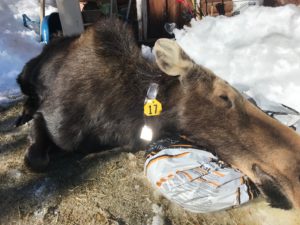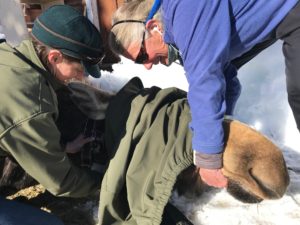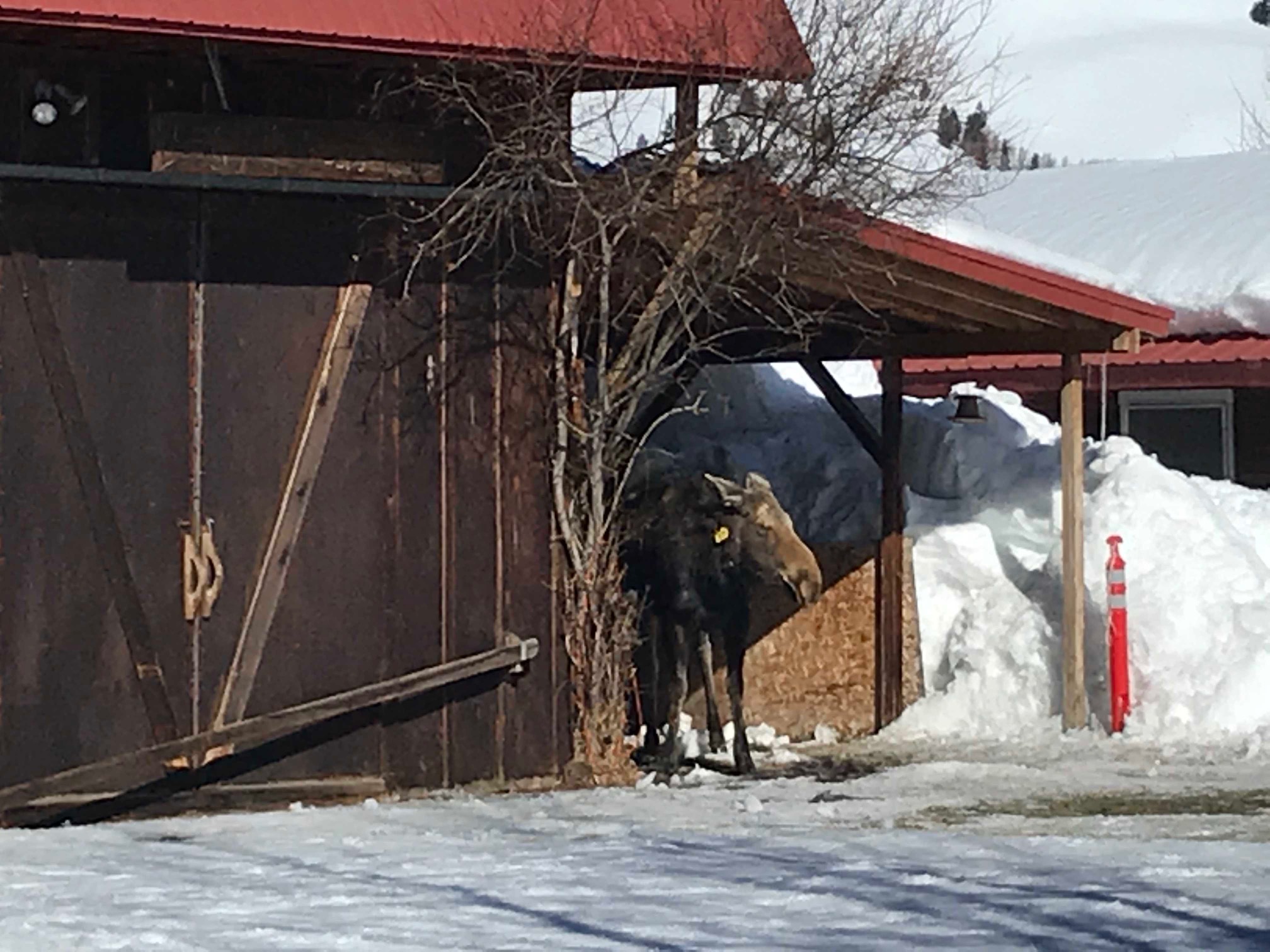Kyle Kissock – Communications Manager
Next time you see a moose along the Moose-Wilson Road, you might notice it sporting something a little different…
Starting this week, the Wyoming Game and Fish Department is fitting ten moose with GPS tracking collars in the vicinity of the Highway 22/390 intersection. The collars have been provided by the Wyoming Department of Transportation, and the goal of collaring moose in this location is to better understand movement patterns in this critical habitat zone. The movement patterns will guide where wildlife underpasses may be installed, in conjunction with the Snake River Bridge replacement project (scheduled for 2022).

In this picture, the soil bag keeps the moose’s head tilted to ensure it’s airway remains clear. We constantly monitored this moose while it was sedated.
Wondering what goes into putting a tracking collar on a live moose? I was lucky enough to tag along and find out how biologists safely collar moose in the field!
It starts with selecting the right moose. As we know, this winter has been hard on ungulates in our valley. Although this process is generally safe for the moose, biologists want to avoid putting undo stress onto already taxed animals, so they will be looking for healthy individuals who are at least yearlings in age; calves are not collared. This project is also specific to the “West Bank” of the Snake River and biologists are only searching for animals which inhabit the Moose-Wilson Road corridor.

Using a coat as a blindfold helps protect the animal’s eyes as the biologist takes a blood sample to identify possible diseases. This moose even got an anti-tick medicine!
We ended up locating a cow- yearling pair who were well-nourished and showed minimal signs of hair loss or disease…perfect candidates for GPS collars.
The darting and collaring process was surprisingly quick, given the size and strength of the animals involved. After the moose were darted in the rumps, where their biggest muscle groups are, it took about 10 minutes for the tranquilizers to take effect. Like humans, drugs effect each critter differently, but these animals went down relatively easily, first to their knees, then bellies to the earth. We approached the moose and made sure they were not lying in positions where the ground could put pressure on their airways; suffocation was the biggest hazard for the sleeping duo, but one that could be easily mitigated. Fun fact: moose aren’t quiet sleepers, they actually snore and drool a little while they snooze!
While a small group of volunteers held the animals’ massive heads to make sure they kept breathing, the biologists drew blood samples to test for diseases and to see if the adult female was pregnant. Generally, a pregnant population of moose is a good indicator the population as a whole is doing ok. The adult female was given antibiotics for a small wound we discovered while collaring her, and even some tick medicine, which as a wild animal is likely as close as she will ever come to getting a veterinarian’s check-up!

The “after” photo, showing the yearling, a little woozy, but happy and healthy with the newly fitted GPS collar and tag. This first thing she did after waking up? Started munching on willows of course!
The next step is fitting and applying the GPS collars. We get questions from time to time about whether the collars will impact the quality of life for the moose (which is a great question). The collars are designed to not encumber the movements of the animal and will actually release, usually after a few years, when sufficient data is acquired. The biologists will then be able to track and recover the dropped collars. While the moose might prefer not to be wearing a necklace, scientists don’t believe these collars negatively influence their lives in any way. In fact, when these two woke up, they seemed utterly unaware anything had changed.
Before the moose were released, biologists injected each animal with a “reversal drug” which kicked in in a matter of minutes. The idea was to limit the time the animals were sedated in order to create as little stress for them possible. This brought both of the moose out of their slumbers, a little dazed, but no worse for the wear.
This project is the first time scientists have collected movement data on this population of “West Bank” moose. In addition to guiding underpass construction, it will also be interesting to find out whether or not these animals are migratory, and if there are specific times of day and certain locations where they are choosing to cross dangerous roads. We will report back when the data starts to come in, so stay tuned!
And when you do see a moose with a collar and a yellow tag, you can be sure that moose is providing important data for a good cause. And continue to drive cautiously, especially on Highways 22 and on 390 at night!
